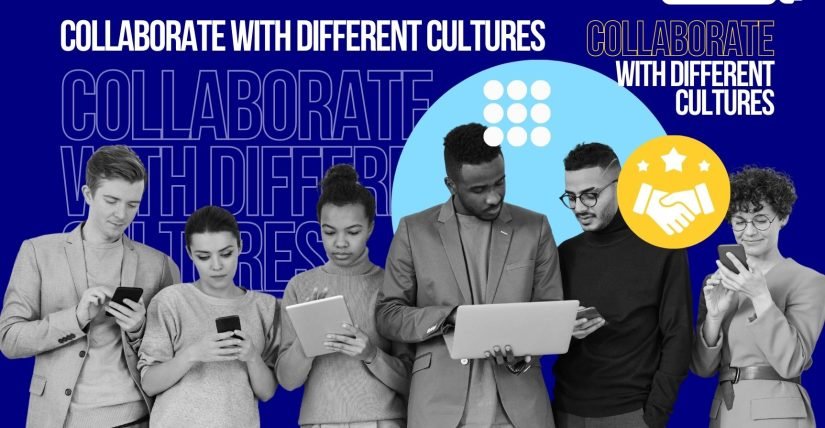Remote work involves working with colleagues from all over the world. The wide range of the global workforce brings in individuals from different locations and diverse cultural backgrounds.
One team member can be from the Philippines, another one from Japan, and the third one from China — all working in the same team. They work from different time zones and contribute to the growth of the organization remotely.
However, diverse cultural backgrounds can pose challenges of cross-cultural differences among the team members. This can disrupt the communication between the team and affect the streamlined working of the organization.
When working in remote culture, with culturally diverse team members, you need to understand and acknowledge their cultural values. This will help you with team bonding and exploring innovative ideas influenced by multiple cultures.
Wondering how to collaborate with different cultures?
Keep reading to know the effective ways you can collaborate with your colleagues from diverse cultural backgrounds.
Understanding Cultural Diversity In Collaboration

It is essential to understand the importance of cultural diversity in team collaboration in remote work culture. Given the fact, that most remote workers belong to different countries, their ethnicities and cultures can influence their collaboration.
Moreover, understanding different cultures can help you foster an inclusive work environment, promote open communication, and acknowledge cultural diversity.
Let’s delve into the relevance of cultural diversity in remote work.
Why Cultural Awareness is Essential for Effective Collaboration
In a remote work culture, cultural awareness is crucial for ensuring effective collaboration. When workers come from different countries and ethnicities, they share their traditions and cultural values with their fellow mates.
This helps in creating a culturally aware work environment, where individuals collaborate with culturally enriched perspectives. Moreover, cultural awareness in remote work can help you in fostering empathy and compassion towards diverse cultures.
The Benefits of Working with Diverse Teams
There are countless benefits of working with a culturally diverse team in a remote work culture. The varied perspectives and creative inputs from cross-cultural teams help in developing innovative ideas.
Moreover, having a culturally diverse team can help in building inclusivity within the company. As the organization becomes symbolic of an inclusive workforce, its reputation is enhanced and brand value improves.
Furthermore, a culturally diverse team provides insightful inputs, indicating top talent acquisition within the organization. They can provide information and details about the local market and help organizations in attracting more customers.
Similarly, the inclusive workforce can contribute to promoting the business as inclusive with culturally aligned ideas and innovations.
Key Cultural Differences that Impact Collaboration
Although having a cross-cultural workforce in remote work organizations is beneficial, however, certain challenges impact cultural collaboration.
In a remote setting, people don’t get the opportunity to meet face-to-face for discussion or team meetings. So, they tend to have comparatively less compassion towards other employees.
If the workforce is not culturally aware, then there are chances of cultural miscommunication, language barriers, and difficulty in time zone coordination. For instance, there can be cultural miscommunication among employees due to a lack of cultural sensitivity training.
Moreover, different cultures use different languages for communication, which can impact the collaboration of the teams. To prevent such communication and collaboration issues, you can incorporate effective open communication and one-language system.
Developing Cultural Intelligence For Better Collaboration

Better collaboration can be ensured with the development of cultural intelligence within the remote workforce. Moreover, introducing the workforce to multiple-cultural content can help them to understand the cultural differences and acknowledge cultural values.
What is Cultural Intelligence?
The idea of cultural intelligence refers to the ability of a person to understand diverse cultural norms and traditions. Additionally, this helps organizations to evaluate the capability of a person to function with a diverse workforce.
The concept was first introduced by P. Christopher Earley and Soon Ang in 2003 to help businesses understand the natural ability of individuals to conform to an inclusive work environment.
Moreover, this concept helps in understanding how the organization can build a collaborative work environment for diverse cultural individuals.
How to Build Cultural Awareness and Sensitivity
To ensure that your team is ready for an inclusive work environment, you need to introduce active learning of diverse cultures within the organization. For instance, employees can be encouraged to discuss their cultural traditions and norms with colleagues.
Moreover, the team members should be encouraged to celebrate different cultures with their teammates. This way they will actively learn about diverse ethnicities and their cultural intelligence will increase.
Similarly, the employees can engage in cultural events through video meetings to celebrate other cultures in a remote setting. This will help in further improving the cultural awareness of the teams, leading to an inclusive work environment.
Recognizing Your Own Cultural Biases
One of the most important and challenging tasks is to identify cultural biases. Cultural biases can gravely affect team collaboration and interfere with cultural diversity in remote work culture.
Moreover, understanding your own cultural biases can help in curbing mistrust towards other cultures and having respect for cross-cultural individuals. These biases based on cultural affiliation can impact the inclusive and collaborative work environment.
Therefore, it is necessary to identify the reasons for biases and eliminate them before they impact the smooth functioning of the organizations. Additionally, when biases are removed, the workers can easily engage in effective team collaborations and improve organizational performance.
Communication Strategies For Cross-Cultural Collaboration

There are numerous strategies that you can adopt to ensure cross-cultural collaboration in remote work. Some of these strategies include:
The Role of Language and Non-Verbal Communication
When you are learning about the different cultures, you will understand the role of language in every culture. People use their cultural languages to communicate their opinions and thoughts.
Moreover, in remote work, you can employ a common language for communication with the teams. This common language will ensure that all the members can understand and contribute to the team discussions.
Apart from this, you should also look into your effective non-verbal communication skills. Your gestures, attitude, and body language should be formal within the work environment to ensure not offend someone else’s culture or ethnicity.
Adapting Your Communication Style to Different Cultures
Another strategy that you can use to ensure effective collaboration of multi-cultures, is adapting your communication styles. When talking to an individual from a different culture, you can adapt your communication style to their culture. This can make them feel seen and acknowledged.
However, you should always remember to be respectful in your approach towards others from different ethnicities. If you mistakenly use certain culturally offensive terms and gestures, make sure to apologize immediately.
Moreover, adapting your communication styles to other cultures can help you to foster better engagement with diverse teams. This will also help you to bridge the communication gap between different cultures.
Overcoming Language Barriers and Misunderstandings
Diverse cultures have diverse languages, which can cause issues like language barriers and misunderstandings. So, in order to prevent such language barriers, you should employ a common language within the workforce to communicate.
This will help cross-cultural employees to communicate without feeling left out or misunderstood. Moreover, using a common language further helps prevent using a cultural language in the wrong sense.
Furthermore, you can employ various visual aids and measures to communicate ideas among diverse cultures. This essentially helps in bridging the language gaps and eradicating communication barriers effectively.
Additionally, this further enhances the inclusivity of the organization and builds a collaborative spirit among the team members.
Best Practices For Effective Cross-Cultural Teamwork

There are numerous practices and strategies used for effective cross-cultural teamwork in remote work culture. Some of these are:
Setting Clear Expectations and Goals
While setting goals and expectations for employees, you need to take into consideration the cultural differences within your workforce. Moreover, the diverse cultural working norms and practices should be thought about before delegating tasks.
In the remote work setting, you should acknowledge the cultural diversity of your workforce and divide work among the team members. Furthermore, you should not have equal expectations from your employees within an inclusive work environment.
Promoting Inclusivity and Respect
In order to promote inclusivity and cross-cultural collaboration, you should include diversity training for the workers, have open communication channels, and establish anti-discrimination company policies.
With the incorporation of these, you can ensure the inclusive nature of your remote work environment. Moreover, you can create a collaborative learning environment for cultural awareness and diverse cultural sensitivity. This will help the workers to understand and respect individuals from multi-cultural teams.
Scheduling Meetings at Convenient Times for All Participants
Another issue with a diverse cultural community within the workforce is the time-zone differences among employees from diverse locations. So, to mitigate this issue, you can schedule video meetings with the time consideration for all individuals.
Moreover, the meeting schedule will enable all the workers from the cross-cultural teams to participate and give their insights. This cross-cultural collaboration eventually helps the organization to identify innovative ideas and creative solutions to integral problems.
Furthermore, when the team members can attend the meetings at their convenient time, they can participate in team activities. Additionally, they can communicate and coordinate tasks across the workers from different locations, increasing team collaboration and cultural intelligence.
Building Trust And Relationships Across Cultures

It is important to establish a trustworthy relationship among your teammates. Moreover, in a diverse work environment, having trust among different cultures is crucial for the success of the business. This can be built by using the following measures:
Establishing Open and Transparent Communication
Open communication and transparency among team members from different cultures can help in fostering trust and building relationships. Moreover, with open communication, you can understand the underlying issues that are interfering with inclusive work culture in your organization.
To ensure that the employees can openly communicate about their diverse perspectives and cultural opinions, you can employ regular team meetings and feedback sessions.
Additionally, these meetings and sessions can help the workers to communicate their problems and reduce misunderstandings. Furthermore, proper incorporation of communicative tools like Slack, Microsoft Teams, and Zoom can help in cultural communication and ensure cultural collaboration.
Showing Respect for Different Cultural Norms and Practices
Once you have learned about the different communities, ethnicities, and cultures, you can celebrate the similarities and differences in these cultures. Moreover, this can help the employees feel acknowledged.
Additionally, the celebration of the differences between diverse cultures can establish respect for other cultures in the employees. The different norms and practices of diversified cultures can give a positive perspective to cultural collaboration.
Furthermore, respecting other cultures can help in building trust among diverse workers and resolve cultural conflicts and biases. This further ensures the effective collaboration of different cultures in remote work.
Building Team Cohesion Despite Cultural Differences
In a remote setting, you can build team cohesion despite cultural diversity through certain measures taken towards building cultural awareness.
These measures include cultural training, active learning of cultural norms and traditions, cultural communication, and flexible management styles.
Moreover, establishing cultural communication among employees can essentially help you in fostering respect for different cultures. Additionally, the shared cultural values and traditions can impact your perspective toward other cultures.
This can help in building team collaboration and trust among diverse employees, despite their cultural differences. Furthermore, this benefits you with innovative ideas from diverse perspectives that lead to overall growth.
Tips And Tricks For Collaborating Effectively With Different Cultures
- Be patient and open-minded when interacting with different cultures.
- Use visual aids to overcome language barriers.
- Actively listen and ask clarifying questions to ensure understanding.
- Educate yourself about the cultural norms and etiquette of team members.
- Foster an inclusive work environment that encourages cultural diversity.
- Adapt your communication style to be more culturally appropriate.
- Use collaboration tools that allow for open and transparent communication.
FAQS
A. You can use visual aids for communication with diverse team members. Moreover, you can employ a common language for workplace communication.
A. Cultural differences like languages, work ethics, traditions, and customs can affect communication and team collaboration.
A. You can build cultural awareness, conduct cultural events to celebrate diverse cultures and employ open communication to ensure all members feel included.
A. You can try to learn different cultures and communicate with different cultural employees. Sharing and exchanging cultural values can help in fostering trust among the team members for each other.
A. You can learn about diverse cultures by engaging with their content, going to their cultural events, and learning their languages.
A. To manage cultural conflicts, you can have open communication among employees and feedback sessions to identify the underlying events of cultural misunderstanding.
A. You can communicate with the members asking about their availability time before scheduling team meetings. Moreover, this will help in mitigating the challenges of meeting scheduling with different time-zones team members.




Leave A Comment